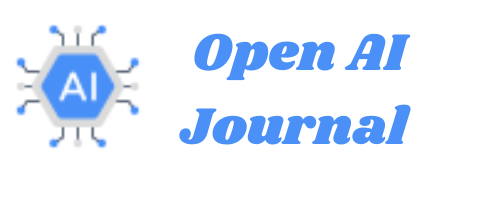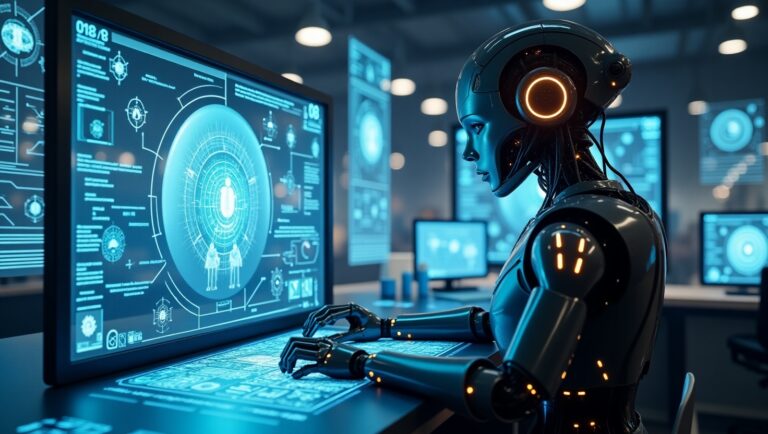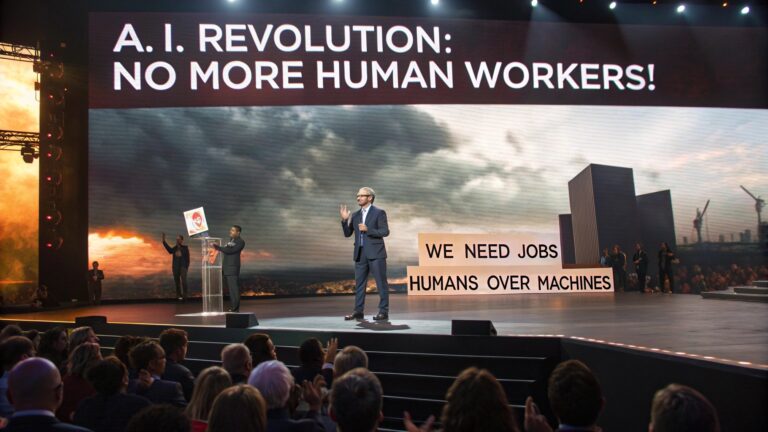Artificial Intelligence Explained: How It Works and Why It Matters Today
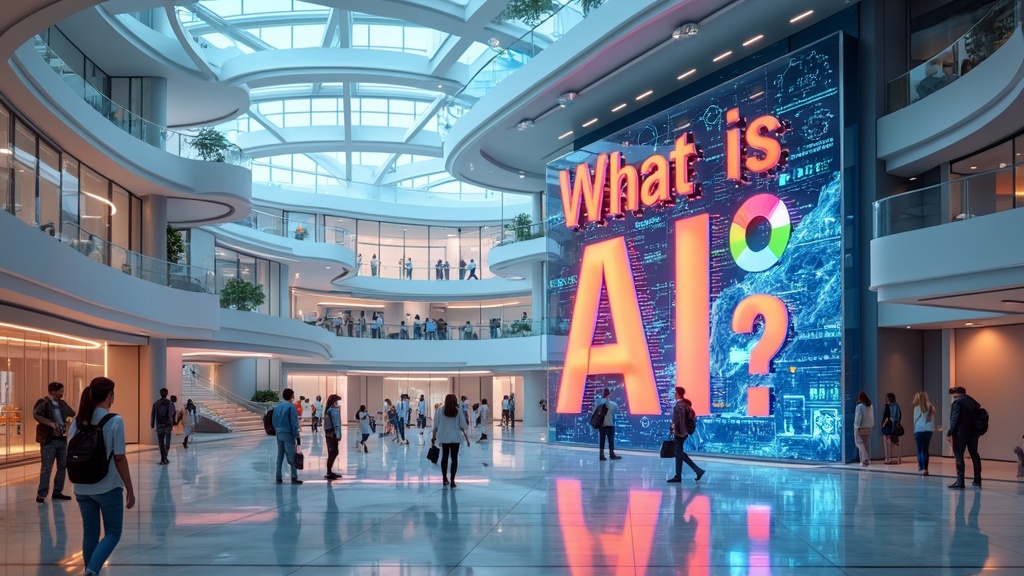
Table of Contents
Introduction
Artificial Intelligence (AI) is no longer just a buzzword—it’s a transformative force that’s already reshaping the world as we know it. From self-driving cars to AI-powered healthcare, the technology is breaking barriers and challenging our understanding of what machines can do. But with AI’s rapid rise comes an unsettling question: Are we creating machines that will one day surpass human intelligence and control? Or are we simply enhancing our ability to solve complex problems and make smarter decisions? The truth lies somewhere in between, and the debate over AI’s potential, its benefits, and its risks has never been more heated.
In this article, we’re diving deep Artificial Intelligence (AI)—what it is, how it works, and why it’s one of the most significant developments of our time. Despite its growing influence, AI remains a mystery to many. Its inner workings, from machine learning algorithms to neural networks, seem complex and intimidating. Yet, understanding AI is crucial not just for tech enthusiasts and industry leaders but for everyone who will be impacted by its widespread integration into our daily lives. AI is already here, and its implications are far-reaching.
While AI promises a future where efficiency, automation, and innovation flourish, it also raises profound ethical questions. Will AI replace jobs and make certain skills obsolete, or will it create new opportunities and enhance human productivity? Can we trust AI to make life-altering decisions, like diagnosing diseases or driving cars? And more importantly, who’s in control of these intelligent systems—the machines, or us? These questions are central to ongoing debates about AI’s future and its potential to either benefit or harm society.
As we explore the mechanics of AI—from machine learning and deep learning to the ambitious goal of Artificial General Intelligence (AGI)—we’ll also delve into the powerful impact this technology is already having. In healthcare, finance, entertainment, and even government, AI is revolutionizing industries. But with great power comes great responsibility. The question remains: Can we navigate the challenges of AI’s rise without losing control of our own future?
This article isn’t just an exploration of AI; it’s a call to action. AI isn’t just changing the way we work—it’s changing what it means to be human. So, the real question is: Are we ready for it?
What is Artificial Intelligence?
Artificial Intelligence (AI) is a multidisciplinary branch of computer science and engineering that aims to build machines capable of performing tasks that typically require human intelligence. These tasks include reasoning, problem-solving, learning, perception, and natural language understanding. The term was first coined at the Dartmouth Conference in 1956, signaling the aspiration to replicate human cognition in machines. Today, AI has evolved into an essential technology driving innovation across industries, reshaping how we interact with the digital and physical world.
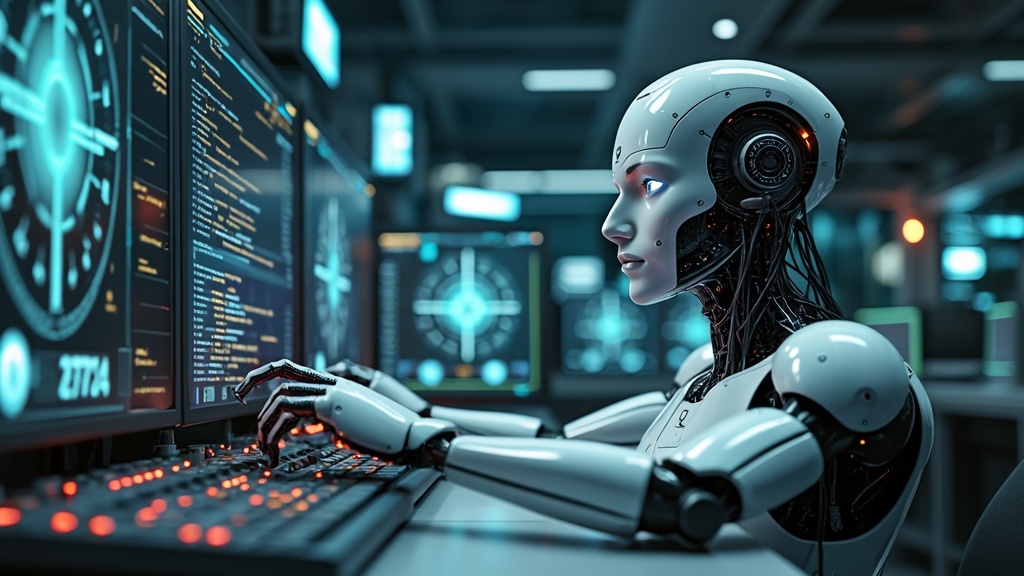
A Broader Definition: Intelligence Beyond Automation
AI goes beyond mere automation, which follows predefined rules and processes. Unlike traditional software, AI systems are designed to analyze data, recognize patterns, adapt to new information, and make decisions—often independently. This adaptability is central to AI’s power, enabling applications that range from virtual assistants to autonomous vehicles.
For example, virtual assistants like Siri and Alexa leverage AI to process spoken language, interpret context, and deliver relevant responses. These systems combine natural language processing (NLP), machine learning, and real-time data analysis to perform complex tasks seamlessly. In a 2023 study, market research firm Statista estimated that 8.4 billion voice-assistant-enabled devices would be in use by 2024, highlighting the growing reliance on AI-powered tools in daily life.
Core Characteristics: Intelligence in Action
AI’s defining characteristic is its ability to simulate human-like cognitive processes. This is achieved through two primary approaches:
- Symbolic AI (also called rule-based AI): Systems rely on explicitly programmed rules and logic to perform tasks. Early AI research focused on this approach, creating systems adept at solving structured problems like chess.
- Statistical AI: This modern approach is data-driven and relies on machine learning techniques, which allow AI systems to learn from data rather than rely on hardcoded rules.
For instance, AI-powered recommendation engines used by platforms like Amazon and Netflix are built on machine learning algorithms. These engines analyze vast datasets to predict user preferences, with Netflix reporting that 80% of its viewers choose shows based on its AI-powered recommendations. Such insights demonstrate how AI not only enhances user experiences but also drives business growth.
The Intelligence Spectrum: Narrow AI to AGI
AI exists on a spectrum of complexity and capability:
- Narrow AI: Most Artificial Intelligence (AI) systems today are narrow, meaning they are specialized to perform specific tasks. Examples include facial recognition, spam filtering, and virtual assistants. Despite their limitations, narrow AI systems are highly effective, contributing to a market projected to grow to $267 billion by 2027, according to Markets and Markets.
- Artificial General Intelligence (AGI): AGI represents a level of AI that could perform any intellectual task a human can. While still theoretical, AGI embodies the aspiration of creating systems with human-like reasoning and problem-solving capabilities. Experts predict that AGI could unlock unprecedented opportunities but also introduce profound ethical and existential challenges.
Why AI Matters Today
AI’s relevance extends beyond its technical definition; it is a driving force behind societal and economic transformation. A PwC report estimates that AI could contribute up to $15.7 trillion to the global economy by 2030. This immense potential is fueled by AI’s ability to process information at scales and speeds unimaginable for humans. In applications like predictive analytics, fraud detection, and climate modeling, AI provides insights that were previously inaccessible.
For example, Artificial Intelligence (AI) systems analyzing satellite imagery can identify deforestation patterns or predict crop yields, directly impacting global efforts to combat climate change and food insecurity. Similarly, healthcare applications such as IBM Watson Health enable faster, more accurate diagnoses by analyzing medical records, saving lives and reducing costs.
AI’s Multifaceted Foundations
The versatility of AI stems from its interdisciplinary nature, drawing from fields such as:
- Computer Science: Provides algorithms, programming, and computational frameworks.
- Mathematics and Statistics: Underpins machine learning models and data analysis techniques.
- Linguistics: Fuels natural language processing, enabling AI to interpret and generate human language.
- Neuroscience and Cognitive Science: Inspire neural network architectures and learning algorithms.
This interdisciplinary foundation empowers AI to mimic various aspects of human intelligence, from learning and memory to problem-solving and creativity.
How Artificial Intelligence Works
Artificial Intelligence (AI) operates at the intersection of data, algorithms, and computational power, enabling machines to emulate cognitive processes such as learning, reasoning, and decision-making. At its core, AI relies on sophisticated techniques like machine learning, neural networks, and natural language processing, which allow it to analyze complex datasets and generate insights or predictions with remarkable accuracy. Understanding how AI works requires a deep dive into its key components, methodologies, and underlying mechanisms.
How Artificial Intelligence Works
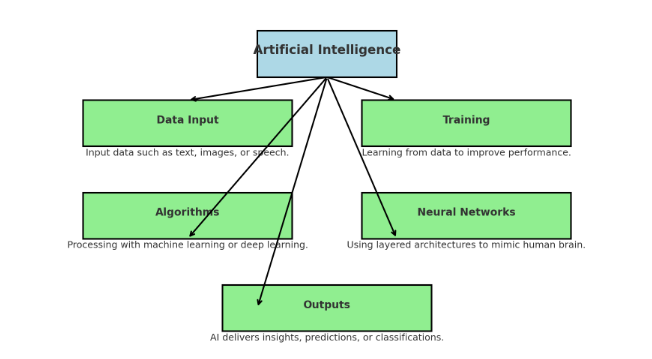
The diagram illustrates the workings of Artificial Intelligence, showing key components like Data Input, Algorithms, Training, Neural Networks, and Outputs. Centralized around AI, arrows connect to each section, highlighting their role in AI’s functionality. Data flows into algorithms and neural networks, undergoes training, and results in actionable outputs.
1. The Building Blocks of AI: Data and Algorithms
The backbone of AI lies in its ability to process and learn from vast amounts of data. AI systems thrive on both structured data (like spreadsheets) and unstructured data (such as images, videos, or text). The success of any AI model depends on the quality and quantity of the data fed into it. According to IDC, the volume of data created globally is expected to reach 175 zettabytes by 2025, underscoring the abundance of raw material for AI applications.
Algorithms as the Engine of Intelligence
AI algorithms are sets of instructions that guide machines in analyzing data and making decisions. These algorithms range from basic linear regression models to complex, multi-layered neural networks. For example:
- In supervised learning, an AI model learns from labeled data (e.g., identifying cats in images tagged as “cat”).
- In unsupervised learning, the model identifies patterns in unlabeled data, such as grouping similar customer profiles for targeted marketing.
- In reinforcement learning, an AI system learns through trial and error, optimizing its behavior based on feedback (e.g., training robots to navigate obstacles).
The adaptability of AI systems comes from their ability to refine these algorithms over time, often achieving higher accuracy and efficiency as they are exposed to more data.
2. Machine Learning: AI’s Core Methodology
Machine Learning (ML), a subset of AI, is the primary mechanism by which AI systems achieve intelligence. Unlike traditional programming, where outcomes are dictated by explicit instructions, ML models “learn” from data. This learning process involves identifying patterns, correlations, and trends that are often imperceptible to humans.
Training and Model Optimization
In ML, models are trained using datasets, with the training process comprising several iterations to minimize errors. For instance:
- An AI model predicting housing prices may start with crude estimates but, through iterative refinement, narrows its predictions to match real-world outcomes.
- Deep Learning, a subset of ML, employs neural networks with multiple layers to achieve higher-order reasoning. For instance, convolutional neural networks (CNNs) excel at image recognition by analyzing visual data through successive layers, identifying everything from edges and textures to entire objects.
Compelling Evidence of ML’s Impact
Google’s DeepMind, using deep reinforcement learning, developed AlphaGo, an AI system that defeated human Go champion Lee Sedol in 2016. This milestone demonstrated not only AI’s ability to learn complex strategies but also its potential to surpass human expertise in specific domains.
3. Neural Networks: Mimicking the Brain
Neural networks are the computational frameworks that underpin many advanced AI systems. These networks are inspired by the human brain’s structure and function, with artificial neurons connected in layers. The data flows through these layers, with each neuron making decisions based on weighted inputs.
How Neural Networks Work
- Input Layer: Accepts raw data (e.g., pixels of an image).
- Hidden Layers: Processes data, extracting features and recognizing patterns.
- Output Layer: Produces the final prediction or classification.
Training a neural network involves adjusting the weights of these connections using techniques like backpropagation, which calculates errors and fine-tunes the model for accuracy.
Practical Applications
Neural networks are central to applications like facial recognition, autonomous driving, and voice assistants. For example, Tesla’s self-driving cars use neural networks to process sensor data in real-time, allowing the vehicle to identify obstacles, traffic signs, and other vehicles.
4. Natural Language Processing: Teaching AI to Understand Language
Natural Language Processing (NLP) enables AI to comprehend and generate human language, bridging the gap between humans and machines. NLP involves tasks such as sentiment analysis, language translation, and text summarization.
Transformative Technologies in NLP
Large language models like OpenAI’s GPT-4 represent the pinnacle of NLP capabilities. These models use billions of parameters to generate human-like text, enabling applications in customer service, content creation, and more. For instance, OpenAI estimates that its ChatGPT system answers millions of queries daily, illustrating NLP’s widespread adoption.
The Challenges of Language Understanding
While NLP has made significant strides, challenges remain, including context interpretation, cultural nuances, and idiomatic expressions. Continued research in this area is crucial to achieving truly seamless human-machine communication.
5. Reinforcement Learning: Learning Through Interaction
Reinforcement learning (RL) involves training AI agents to make decisions in dynamic environments by maximizing rewards. This approach is particularly effective in applications where outcomes depend on sequences of actions, such as robotics or game-playing.
Examples of RL in Action
- In healthcare, RL models are being used to optimize treatment strategies, such as personalized drug dosing for chronic conditions.
- DeepMind’s RL-based AI, AlphaFold, revolutionized biology by predicting protein structures with unprecedented accuracy, accelerating drug discovery efforts.
6. The Role of Computational Power and Cloud Infrastructure
The computational demands of AI are immense. Modern AI systems require vast processing capabilities, often relying on specialized hardware like Graphics Processing Units (GPUs) and Tensor Processing Units (TPUs). Cloud platforms such as Google Cloud, AWS, and Microsoft Azure have democratized access to AI by providing scalable computing resources.
Statistics on AI’s Growth
The global AI market is projected to reach $267 billion by 2027, driven largely by advancements in computational power and data availability. Additionally, Statista reports that over 50% of organizations now rely on cloud-based AI solutions, highlighting the importance of infrastructure in AI’s growth.
7. Continuous Learning and Adaptation
One of AI’s most transformative features is its ability to learn continuously. Unlike static software, AI systems improve as they interact with their environments and accumulate data. This capability enables real-time decision-making and adaptation, making AI indispensable in areas like autonomous vehicles and predictive analytics.
Artificial Intelligence works by combining powerful algorithms, computational resources, and vast datasets to achieve human-like reasoning and adaptability. Its mechanisms, ranging from neural networks to reinforcement learning, form the foundation of a technology that is reshaping industries and redefining the boundaries of human potential. As AI continues to evolve, understanding its inner workings is crucial for leveraging its transformative capabilities responsibly.
Types of Artificial Intelligence
Artificial Intelligence (AI) is a rapidly evolving field with varying degrees of complexity and application. AI is typically categorized based on its level of intelligence, capability to perform tasks, or the stages of its development. These classifications provide insights into both the current capabilities of AI and the potential future trajectory of the field. By understanding the different types of AI, we can better appreciate the broad spectrum of possibilities—from narrow AI systems designed for specific tasks to speculative forms of superintelligence that could radically change how society operates.
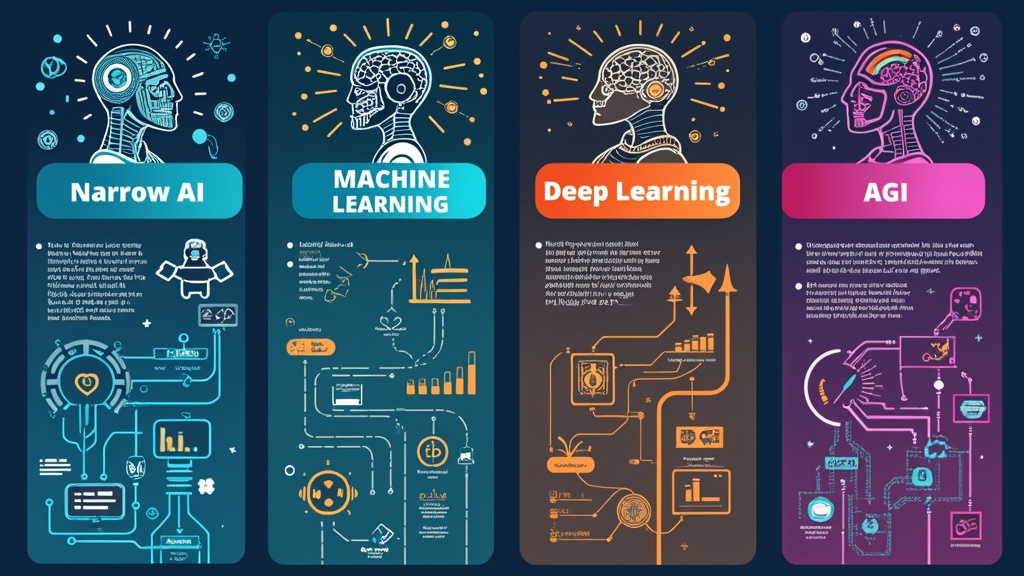
1. Narrow AI (Weak AI)
Narrow AI, also referred to as Weak AI, represents the most common and widespread form of AI today. These systems are designed and trained to perform a specific task, excelling in a narrow scope but lacking the ability to generalize to other tasks or situations. Unlike human intelligence, which is adaptable and can tackle a wide range of challenges, narrow AI is highly specialized.
Key Characteristics of Narrow AI
- Task-specific: Narrow AI operates within a confined domain, such as playing chess, recognizing faces, or providing weather forecasts.
- Predefined functions: These systems operate based on pre-programmed instructions or models trained on large datasets.
- No learning outside its domain: Narrow AI cannot perform tasks outside of its predefined scope without additional programming or training.
Real-World Applications of Narrow AI
Narrow AI is already embedded in everyday life and industries. For instance:
- Virtual Assistants: AI-powered assistants like Amazon’s Alexa or Apple’s Siri are prime examples of narrow AI. They excel at answering simple queries, setting reminders, or controlling smart home devices but cannot perform tasks outside their specific functions.
- Autonomous Vehicles: While self-driving cars demonstrate impressive capabilities in navigation, object detection, and route planning, these systems are restricted to the tasks they are trained to handle and are still learning to navigate complex, real-world environments.
Statistically, narrow AI has seen widespread adoption across industries, with PwC predicting that AI could contribute up to $15.7 trillion to the global economy by 2030, largely driven by advancements in narrow AI applications like automation and data analytics.
2. General AI (Artificial General Intelligence – AGI)
Artificial General Intelligence (AGI), also known as Strong AI, represents a more advanced form of AI that aims to mimic human cognitive abilities across a wide range of tasks. Unlike narrow AI, AGI is capable of understanding, learning, and applying knowledge in a way that resembles human intelligence. AGI can not only perform specific tasks but also generalize its knowledge across different domains, allowing it to solve problems and adapt to new situations, much like humans do.
Key Characteristics of AGI
- Human-like reasoning: AGI can reason, plan, solve problems, think abstractly, comprehend complex ideas, and learn from experience.
- Adaptability: Unlike narrow AI, AGI can shift between tasks and environments with minimal retraining.
- Self-improvement: AGI systems could improve their performance autonomously over time, leveraging ongoing interactions with the world.
Current State of AGI
Despite significant progress in AI, AGI remains theoretical and has not been achieved yet. The field is still grappling with challenges in understanding how to replicate the full breadth of human cognitive abilities. Experts such as Stephen Hawking and Elon Musk have expressed concerns about the ethical implications and risks of AGI, suggesting that careful control and regulation will be necessary to prevent potential harms.
Estimates for when AGI might become a reality vary significantly, but some researchers believe that it could take decades or even longer before true AGI is developed. According to a 2016 survey of AI experts conducted by the Future of Humanity Institute, there is a 50% chance of AGI being developed by 2060, with a 10% chance that it will occur by 2022.
3. Superintelligent AI (Artificial Superintelligence – ASI)
Artificial Superintelligence (ASI) refers to a form of AI that surpasses human intelligence in every domain, including creativity, problem-solving, decision-making, and emotional intelligence. Unlike AGI, which seeks to replicate human cognitive abilities, ASI would exceed the capabilities of the human brain, functioning at a level far beyond our most intelligent minds.
Key Characteristics of ASI
- Superior Problem Solving: ASI would have the ability to solve complex problems across multiple fields, from quantum physics to global governance, more efficiently than humans.
- Advanced Creativity: ASI could potentially excel in fields such as art, music, and scientific discovery, generating innovative ideas and solutions that we cannot currently conceive.
- Emotional and Social Intelligence: Unlike both narrow AI and AGI, ASI could potentially understand human emotions and social dynamics on an advanced level, making it capable of engaging in meaningful relationships with humans.
Theoretical Nature of ASI
Like AGI, ASI remains speculative at this stage. However, experts in AI and futurism, such as Ray Kurzweil, argue that ASI is a natural progression of the technological advancement of AI. Kurzweil’s prediction of the singularity, a point where machines surpass human intelligence and become self-improving, envisions a future where ASI could radically transform every aspect of life on Earth.
While ASI presents immense possibilities, it also raises significant concerns. One of the key risks is the control problem, which refers to the challenge of ensuring that ASI operates in ways that align with human values and ethics. The consequences of misaligned superintelligence are far-reaching, from economic displacement to existential threats.
4. Reactive Machines (Early AI Systems)
The simplest form of AI, Reactive Machines, operates by responding to specific stimuli with predefined behaviors. These AI systems do not store memories or learn from experience, and as such, cannot improve their performance over time. Reactive machines are limited to specific actions and responses and cannot adapt to new situations or use past interactions to influence future decisions.
Key Characteristics of Reactive Machines
- Predefined behavior: These AI systems are programmed with a set of rules that guide their actions based on particular inputs.
- No learning: Reactive machines do not retain past interactions and cannot use previous experiences to alter their behavior in future situations.
Real-World Examples of Reactive Machines
One of the most notable examples of reactive machines is IBM’s Deep Blue, which famously defeated chess champion Garry Kasparov in 1997. Deep Blue did not learn from its matches; it simply processed the current game state and selected the optimal moves based on a vast database of chess strategies.
Although reactive machines are limited in scope, they still provide valuable contributions in specialized areas, such as manufacturing automation and routine administrative tasks.
5. Limited Memory AI
Limited Memory AI refers to systems that can learn from historical data and improve their performance over time. Unlike reactive machines, limited memory AI models can retain information from past experiences, but this memory is typically short-term and used to inform decision-making within a constrained period or context.
Key Characteristics of Limited Memory AI
- Short-term memory: These systems can learn from past data but do not have the long-term memory or ability to adapt to new situations autonomously in the same way AGI or ASI might.
- Learning from experience: Limited memory AI uses past data to make better predictions, such as in predictive analytics or dynamic recommendation systems.
Applications of Limited Memory AI
A common use case for limited memory AI is in autonomous vehicles, where the system must continually process real-time data, such as traffic conditions, road signs, and nearby vehicles, to navigate safely. Another example is recommendation engines used by companies like Netflix or Amazon, which leverage historical user data to suggest relevant movies, products, or services.
AI’s diverse types, from narrow AI to speculative superintelligence, offer a fascinating view of the possibilities that lie ahead. While narrow AI dominates today’s technological landscape, AGI and ASI promise radical transformations in both cognitive and societal realms. As AI continues to evolve, understanding its stages of development and its varied types will be crucial for anticipating its potential impacts, ethical considerations, and the changes it will bring to industries, economies, and humanity as a whole. With advancements moving rapidly, it is not a question of if but when we will encounter these more advanced forms of AI, each step presenting its own set of challenges and opportunities.
Why Artificial Intelligence Matters Today
Artificial Intelligence (AI) has become one of the most influential and transformative technologies in modern society, reshaping industries, economies, and everyday life. From healthcare to finance, education, transportation, and beyond, AI is not just a future possibility—it’s a present reality that is already driving profound changes in how we live and work. But why does AI matter so much today? To answer this question, it’s essential to consider the multifaceted roles AI plays in solving complex challenges, improving productivity, unlocking new opportunities, and addressing critical global issues.
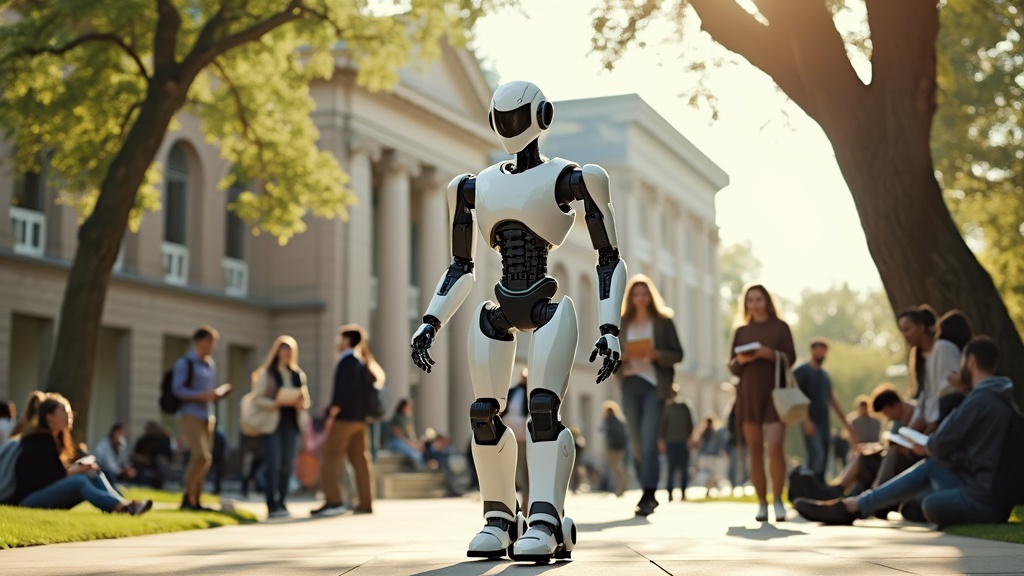
1. Driving Economic Growth and Innovation
One of the primary reasons Artificial Intelligence (AI) matters today is its significant impact on economic growth. AI has the potential to unlock immense value by improving efficiency, automating tasks, and enhancing decision-making. According to a 2017 PwC report, AI could contribute an estimated $15.7 trillion to the global economy by 2030, with the largest economic gains expected in China and North America. This growth stems from AI’s ability to automate labor-intensive tasks, reduce operational costs, and enable faster innovation cycles in various sectors.
- Automation and Efficiency: Artificial Intelligence (AI) can automate repetitive, mundane tasks, which allows human workers to focus on higher-value activities that require creativity, strategic thinking, and emotional intelligence. In manufacturing, for instance, robots powered by AI can work alongside humans to streamline assembly lines, reducing human error and increasing production rates.
- Enhanced Decision-Making: AI-driven data analytics enable businesses to make more informed and accurate decisions by identifying patterns, predicting future trends, and uncovering insights hidden within large datasets. For instance, AI in finance is revolutionizing trading strategies by enabling real-time analysis of market conditions, resulting in better risk management and more lucrative investments.
A notable example of AI’s economic impact is the adoption of AI in healthcare, where AI systems are helping doctors analyze medical images with accuracy that rivals human experts, leading to faster diagnoses and improved patient outcomes. According to Accenture, AI in healthcare could create $150 billion in annual savings for the U.S. healthcare economy by 2026, largely through improved diagnostic accuracy, early detection of diseases, and personalized treatments.
2. Enhancing Healthcare and Quality of Life
AI’s importance is perhaps most acutely felt in the healthcare sector, where its potential to revolutionize diagnostics, treatment, and patient care is profound. The integration of AI into medical systems has already begun to make a tangible difference in how healthcare is delivered, making it more accessible, efficient, and personalized. By automating routine tasks, AI frees up medical professionals to focus on complex cases, while also increasing the accuracy and speed of diagnoses.
AI in Healthcare Applications
- Medical Imaging and Diagnostics: Artificial Intelligence (AI) systems like Google’s DeepMind are capable of analyzing medical images with near-human accuracy, identifying early signs of conditions like cancer, heart disease, and retinal issues. Research has shown that AI algorithms can be as effective, or even superior, to human doctors in certain diagnostic tasks. For example, a study published in JAMA Network Open demonstrated that an AI system could identify breast cancer with an accuracy of 94.6%, compared to 88% for human radiologists.
- Personalized Medicine: AI is driving the shift toward personalized medicine, where treatments and medications are tailored to individual patients based on their genetic makeup, lifestyle, and medical history. AI algorithms are being used to predict how patients will respond to specific drugs, minimizing adverse reactions and improving treatment outcomes.
AI is also playing a pivotal role in managing chronic diseases. Systems that leverage machine learning to monitor patient data in real time are already being used to manage conditions like diabetes and hypertension, helping patients avoid complications and improving overall health management.
3. Transforming Transportation and Mobility
Transportation is another area where Artificial Intelligence (AI) is already having a profound impact. With innovations in autonomous vehicles, AI is poised to fundamentally reshape how people and goods move, improving safety, efficiency, and environmental sustainability. Autonomous vehicles, for example, have the potential to reduce traffic accidents, lower fuel consumption, and decrease emissions—transforming entire urban infrastructures.
AI and Autonomous Vehicles
- Safety Improvements: According to the World Health Organization (WHO), approximately 1.35 million people die each year in traffic accidents. AI-powered autonomous vehicles could drastically reduce this number by eliminating human errors such as distracted driving, speeding, or impaired driving. Self-driving cars equipped with AI sensors can detect obstacles, analyze road conditions, and react in real-time to prevent accidents.
- Environmental Impact: Autonomous vehicles could lead to more efficient use of road networks, reducing traffic congestion and lowering emissions. AI also enables more precise traffic management systems that optimize traffic flow and reduce fuel consumption, contributing to greener cities.
The global autonomous vehicle market is projected to reach $557 billion by 2026, reflecting the vast potential of AI to reshape transportation systems worldwide. Companies like Tesla, Waymo (Google’s self-driving unit), and others are investing heavily in AI technologies that enable vehicles to navigate without human intervention, with advancements in AI proving essential to the viability and safety of these technologies.
4. Addressing Global Challenges
AI is not just transforming industries—it’s also playing an increasingly vital role in tackling some of the world’s most pressing challenges. These include climate change, food security, and disease outbreaks. AI’s ability to analyze large volumes of data, predict outcomes, and optimize resource use makes it an invaluable tool for addressing complex global issues.
AI and Climate Change
AI can help mitigate the effects of climate change by optimizing energy use, improving the efficiency of renewable energy systems, and providing better models for understanding climate patterns. For example, AI can predict weather patterns and help energy grids balance supply and demand more efficiently, ensuring that renewable energy sources like solar and wind are integrated into the grid more effectively.
- Energy Efficiency: AI-powered smart grids can monitor energy consumption in real time, adjusting energy distribution based on demand and minimizing waste. AI is also used in predictive maintenance for renewable energy infrastructure, such as wind turbines, ensuring optimal performance and reducing downtime.
AI and Agriculture
In agriculture, AI systems are helping farmers increase crop yields, reduce waste, and improve food security. AI-driven systems can monitor soil health, weather conditions, and crop growth to provide real-time recommendations on irrigation, fertilization, and pest control. This precision agriculture can significantly reduce resource consumption and increase food production to meet the growing global demand.
According to McKinsey, AI could increase global agricultural productivity by up to 70% by 2050, which will be crucial in feeding a population that is expected to reach nearly 10 billion by mid-century.
5. Ethical Considerations and Challenges
Despite its undeniable benefits, AI also brings forward important ethical considerations that society must address to ensure that its implementation is responsible, equitable, and aligned with human values. Issues such as privacy, bias, job displacement, and accountability need careful attention as AI systems become more integrated into decision-making processes.
- Bias and Fairness: AI systems are only as good as the data they are trained on. If the training data reflects biased or discriminatory patterns, AI systems can perpetuate these biases. This has raised significant concerns in areas such as hiring, law enforcement, and lending. For instance, studies have shown that facial recognition technology has higher error rates for people of color and women, raising questions about the fairness of such systems in high-stakes environments.
- Job Displacement: While AI can create new opportunities and drive innovation, it also poses the risk of displacing workers in industries like manufacturing, retail, and transportation. According to a McKinsey report, AI could automate up to 30% of global work activities by 2030, leading to job displacement for millions of workers worldwide. This will require comprehensive policies to reskill workers and ensure that the benefits of AI are broadly shared.
The relevance of Artificial Intelligence (AI) today cannot be overstated. From enhancing productivity and driving economic growth to addressing global challenges like climate change and food security, AI is revolutionizing industries and reshaping the world. However, as AI continues to evolve, it is essential to remain vigilant about its ethical implications and ensure that its benefits are distributed fairly across society. As AI technologies become increasingly ingrained in our daily lives, understanding their potential, as well as their limitations, will be crucial for harnessing their power responsibly and ensuring that AI becomes a force for good.
Challenges and Ethical Considerations in Artificial Intelligence
While Artificial Intelligence (AI) presents extraordinary potential to transform industries and improve global living standards, it also raises profound challenges and ethical concerns that demand careful consideration. As AI systems become more deeply integrated into decision-making processes, from healthcare to law enforcement, and from finance to education, it is crucial to balance technological advancement with ethical integrity. These challenges primarily stem from issues such as bias and fairness, transparency, accountability, job displacement, privacy, and the potential for misuse. Addressing these issues requires not only technical solutions but also a broad societal discourse on how AI should be designed, implemented, and governed.
1. Bias and Discrimination in AI Systems
One of the most pressing ethical concerns surrounding Artificial Intelligence (AI) is the risk of bias. AI systems, particularly those based on machine learning algorithms, are trained on large datasets that are often drawn from historical data, which can reflect societal inequalities. If the data used to train AI models contain biases, the AI system may inadvertently reproduce or even amplify those biases, leading to unfair and discriminatory outcomes. This is especially concerning in areas like hiring, criminal justice, and lending, where biased decisions can have life-altering consequences.
- Hiring Algorithms: One notable case of AI bias occurred in 2018 when it was discovered that an AI recruitment tool used by Amazon was biased against women. The system, which was designed to help Amazon streamline its hiring process, was trained on resumes submitted over a 10-year period, a majority of which came from male applicants. As a result, the AI system began to favor male candidates and penalize resumes that included words typically associated with women. In this case, the AI model reinforced existing gender biases, undermining the goal of increasing diversity and fairness in hiring practices.
- Criminal Justice and Law Enforcement: In the criminal justice system, AI-driven predictive policing algorithms have been criticized for perpetuating racial bias. For instance, COMPAS (Correctional Offender Management Profiling for Alternative Sanctions), a widely used algorithm in the U.S. courts to assess the risk of reoffending, was found to be biased against Black defendants. Research by ProPublica revealed that the algorithm was twice as likely to falsely flag Black defendants as high-risk compared to white defendants, even when controlling for criminal history and other factors. This raises questions about the fairness of AI in critical decisions related to criminal sentencing and parole.
The problem of bias in Artificial Intelligence (AI) is not limited to any one industry. It is a pervasive issue that requires systemic changes to data collection practices, algorithm design, and oversight. To mitigate bias, AI systems must be trained on diverse, representative datasets, and developers should incorporate fairness metrics into the model evaluation process.
2. Transparency and Explainability
As AI systems become more sophisticated, their decision-making processes often become increasingly opaque. This lack of transparency is particularly concerning in applications where AI is making high-stakes decisions that affect people’s lives, such as in healthcare diagnostics, hiring, or criminal justice. The phenomenon known as the “black box” problem arises when AI models, especially deep learning models, become so complex that even their creators cannot fully explain how or why they arrived at a particular decision.
The absence of transparency in AI systems undermines trust in these technologies. If users cannot understand how an AI system makes decisions, they may be less willing to rely on its outputs, especially when those outputs can have significant consequences. This is particularly true in high-risk sectors like healthcare, where the decision to administer a specific treatment based on AI recommendations could potentially save or endanger a patient’s life.
- Explainable AI (XAI): To address the transparency issue, the field of Explainable AI has emerged. XAI aims to create models that not only perform well but can also provide clear, interpretable explanations for their decisions. For instance, in medical imaging, AI models are being developed to not only detect diseases but also explain the reasoning behind their predictions in human-understandable terms. This approach ensures that healthcare providers can validate and trust the AI’s decision-making process before making critical decisions.
Transparency is especially important in regulated industries where accountability and traceability are necessary to meet legal and ethical standards. The European Union’s General Data Protection Regulation (GDPR) includes provisions that demand “explainability” in AI decision-making, giving individuals the right to understand how decisions affecting them are made by automated systems.
3. Accountability and Liability
As AI systems take on more responsibility in decision-making processes, questions about accountability and liability become increasingly urgent. If an AI system makes a harmful decision—such as a self-driving car causing an accident, or an AI system denying a loan based on discriminatory factors—who is responsible for the consequences?
- Legal and Ethical Accountability: Currently, accountability in AI systems is a gray area. In many cases, it is unclear whether responsibility lies with the developers of the AI, the organizations deploying the technology, or the AI system itself. In the event of an accident involving autonomous vehicles, for example, should the manufacturer of the vehicle, the developer of the AI system, or the driver be held accountable? As AI systems become more autonomous, establishing clear legal frameworks for responsibility is crucial.
- Liability in Healthcare: Similarly, in healthcare, if an AI system misdiagnoses a patient or recommends an inappropriate treatment, it’s unclear who should be held liable: the healthcare provider, the developer of the AI tool, or the institution using the AI. Clear legal guidelines are needed to determine liability in AI-driven decisions, ensuring that victims of AI-related harm have access to justice and compensation.
A related concern is that Artificial Intelligence (AI) systems can sometimes make errors that are difficult to foresee or prevent, raising the question of whether it is possible to design AI systems that are entirely risk-free. The development of safety-critical AI systems—those that operate in environments where failure could result in serious harm (e.g., autonomous vehicles, medical devices)—must be accompanied by strict testing, certification processes, and regulations to minimize risks.
4. Job Displacement and Economic Inequality
Another significant ethical concern surrounding AI is its potential to disrupt the workforce, particularly in industries where automation and AI-powered systems can replace human labor. While AI is expected to create new job opportunities, it will also render many existing jobs obsolete, particularly those that involve routine or manual tasks. This presents a challenge in terms of both economic inequality and social stability.
- Impact on Employment: According to a McKinsey Global Institute report, as much as 30% of global work activities could be automated by 2030, affecting hundreds of millions of jobs worldwide. Sectors like manufacturing, transportation, and retail are particularly vulnerable to automation. For instance, self-checkout systems and warehouse robots have already replaced human workers in many retail and logistics operations. Similarly, the rise of autonomous vehicles threatens millions of driving-related jobs, such as truck drivers, taxi drivers, and delivery drivers.
- Economic Inequality: The rapid adoption of AI could exacerbate existing economic inequalities. Those who possess the skills required to work alongside AI technologies—such as data scientists, engineers, and machine learning experts—will likely see increased job opportunities and higher wages. However, workers in low-skilled jobs that are easily automated may face unemployment and reduced economic mobility. This could lead to greater wealth disparities and social unrest if not properly managed.
Addressing this challenge requires proactive measures, including reskilling and upskilling initiatives, social safety nets, and policies that promote inclusive economic growth. The World Economic Forum estimates that by 2025, AI could displace 85 million jobs, but it could also create 97 million new roles that are more adapted to the changing labor market. The focus, therefore, should be on ensuring that workers displaced by AI are equipped with the skills required for emerging jobs.
5. Privacy and Surveillance Concerns
Finally, AI’s ability to collect, analyze, and interpret vast amounts of personal data raises significant privacy concerns. AI-powered systems, such as facial recognition and predictive analytics, can track individuals’ movements, behaviors, and preferences, often without their knowledge or consent. This has led to growing fears about mass surveillance, data breaches, and the erosion of privacy rights.
- Facial Recognition: One of the most controversial uses of AI in surveillance is facial recognition technology, which has been adopted by governments and private companies for purposes ranging from security to marketing. A report by the American Civil Liberties Union (ACLU) revealed that one in two American adults are in a law enforcement facial recognition database, raising concerns about the lack of consent and the potential for misuse in policing, especially in marginalized communities.
- Data Privacy: The increasing use of Artificial Intelligence (AI) to process personal data also brings up questions of consent, security, and ownership. Data privacy regulations, such as the European Union’s GDPR, are a step in the right direction to ensure that individuals have control over how their data is used. However, as AI systems grow more advanced, it will be critical to develop robust frameworks that protect personal data from misuse and prevent companies or governments from exploiting sensitive information.
The challenges and ethical considerations surrounding Artificial Intelligence (AI) are complex and multifaceted. While AI holds immense promise for improving industries and addressing global challenges, it also raises critical issues that cannot be overlooked. As AI technologies continue to evolve, it is essential to foster transparent, accountable, and equitable AI development that prioritizes human rights, privacy, and fairness. By tackling these challenges proactively, society can ensure that AI serves as a force for good, creating a more just and prosperous future for all.
The Future of AI
As we look ahead, the future of Artificial Intelligence (AI) holds tremendous promise, but it also presents profound uncertainties and challenges. The accelerating development of AI technologies, coupled with advances in machine learning, natural language processing, robotics, and autonomous systems, is poised to dramatically transform virtually every facet of human life. From healthcare to education, from climate change mitigation to global supply chains, AI is set to revolutionize industries and redefine the very nature of human work and interaction. However, the direction in which AI evolves will depend on how society navigates key issues surrounding ethics, governance, societal impact, and technological capabilities.
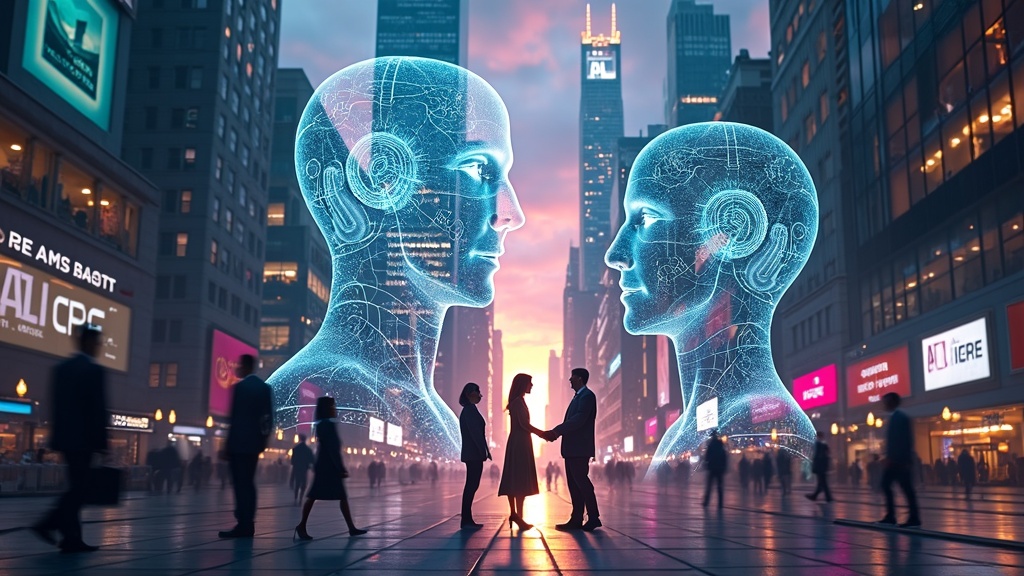
1. The Rise of Artificial General Intelligence (AGI)
One of the most anticipated developments in Artificial Intelligence (AI) research is the quest for Artificial General Intelligence (AGI)—machines that can perform any cognitive task that a human can. Unlike narrow AI, which excels at specialized tasks (e.g., playing chess, driving a car, or recommending movies), AGI would have the ability to learn, adapt, and apply knowledge across a wide variety of domains. It would possess common sense, creativity, and the ability to transfer knowledge from one field to another.
While AGI remains theoretical, several advancements suggest we are moving closer to its realization. The progress made in deep learning, neural networks, and reinforcement learning have already yielded significant improvements in AI’s ability to solve complex problems. OpenAI’s GPT-3, for instance, demonstrates the remarkable ability of AI to generate human-like text across a wide range of topics, showcasing an early form of generalized reasoning. However, AGI is still a long way off, and experts disagree on how soon it might arrive. Some, like Ray Kurzweil, predict that AGI could be achieved as early as 2045, while others remain more cautious, suggesting it may take much longer or may never be fully realized.
The development of AGI would fundamentally alter society. It could drive exponential technological innovation and open up new frontiers in science and engineering. However, it also raises existential risks. If AGI surpasses human intelligence (a scenario known as the singularity), questions about control, ethics, and safety become paramount. Researchers like Nick Bostrom argue that we must ensure that AGI is aligned with human values and goals to prevent unintended consequences. As we inch closer to AGI, it will be critical to develop rigorous safety protocols and governance structures.
2. The Role of AI in Augmenting Human Capabilities
In the near term, AI will likely focus less on replacing human workers and more on augmenting human capabilities. The fusion of AI with human intelligence, often referred to as cognitive augmentation, will create new opportunities for collaboration between humans and machines. In many industries, AI will serve as a powerful tool to enhance human decision-making, creativity, and productivity, rather than replace human workers altogether.
- Healthcare: AI’s potential to augment human capabilities in healthcare is already being realized. For example, AI-powered diagnostic tools are helping doctors detect diseases like cancer at earlier, more treatable stages. Companies like PathAI are using machine learning to analyze medical images and assist pathologists in identifying patterns that might be missed by the human eye. AI will also play a critical role in precision medicine, where algorithms can analyze genetic data to recommend personalized treatments. These technologies will empower healthcare professionals to make more accurate decisions, ultimately improving patient outcomes.
- Education: In education, AI will act as a personalized tutor, helping students learn at their own pace and according to their own learning styles. Adaptive learning systems powered by AI can identify students’ strengths and weaknesses, providing tailored educational experiences that traditional classroom settings cannot. This could revolutionize education by making it more inclusive and accessible, especially in underprivileged areas where resources are scarce.
- Creativity and Innovation: AI is also beginning to play a role in augmenting human creativity. AI tools can generate art, compose music, and even assist in writing. For instance, DALL·E 2—an image generation tool—allows artists to collaborate with AI to create visuals that they might not have imagined on their own. Similarly, AI-powered music generation tools like Aiva are helping composers explore new musical ideas. While AI will not replace human artists, it will become an invaluable tool for creative expression, enabling more people to unlock their artistic potential.
3. AI’s Impact on Employment and the Workforce
The future of Artificial Intelligence (AI) will also have significant implications for the labor market. On the one hand, AI-driven automation is likely to displace certain types of jobs, particularly those involving repetitive tasks or manual labor. For example, self-driving vehicles could revolutionize the transportation sector, threatening jobs for truck drivers, delivery personnel, and taxi operators. Similarly, AI-powered chatbots and virtual assistants could replace customer service representatives and call center workers.
However, while automation may lead to the elimination of certain jobs, it will also create new opportunities. As AI automates more routine tasks, humans will be freed up to focus on higher-level work that requires creativity, emotional intelligence, and complex problem-solving. McKinsey & Company estimates that by 2030, AI could displace 75 million jobs, but it will also create 133 million new roles, particularly in fields like AI development, data science, cybersecurity, and human-AI collaboration.
For this transition to be successful, there needs to be a concerted effort to reskill and upskill workers who are at risk of displacement. Educational institutions, governments, and businesses will need to invest in programs that equip workers with the skills required to thrive in an AI-driven economy. These include digital literacy, AI programming, and critical thinking skills.
4. The Rise of Autonomous Systems and Robotics
The future of Artificial Intelligence (AI) will also see significant advances in autonomous systems and robotics, which will transform industries ranging from manufacturing to logistics, healthcare to space exploration. These systems, powered by AI, will operate independently, performing tasks without human intervention.
- Autonomous Vehicles: Self-driving cars, trucks, and drones are some of the most widely anticipated applications of AI. Waymo, an Alphabet subsidiary, is already testing autonomous taxis in select U.S. cities, and companies like Tesla are continually advancing their self-driving technologies. The widespread adoption of autonomous vehicles could reduce traffic accidents, improve transportation efficiency, and make mobility more accessible to individuals with disabilities or the elderly. However, regulatory, safety, and ethical considerations will need to be addressed before autonomous vehicles can be fully integrated into society.
- Robotics in Manufacturing: AI-powered robots have already revolutionized manufacturing by enabling 24/7 operations, reducing costs, and increasing precision. These robots are not only performing tasks such as assembly and welding but are also being designed to work collaboratively with human workers in co-bots (collaborative robots). This development enables greater flexibility and adaptability in manufacturing processes.
- Healthcare Robots: In healthcare, autonomous robots could assist with surgeries, rehabilitation, and elderly care. For example, Robotic Process Automation (RPA) is already being used to perform routine administrative tasks in hospitals, freeing up healthcare professionals to focus on more complex patient care. Robotic surgeries, led by systems like da Vinci, allow for minimally invasive procedures, faster recovery times, and increased precision.
5. Ethical and Governance Challenges
As Artificial Intelligence (AI) technologies continue to evolve, the need for robust governance frameworks and ethical guidelines becomes more pressing. AI’s ability to process vast amounts of data and make decisions autonomously raises significant concerns about privacy, security, and accountability. To ensure that AI benefits society, it will be crucial to establish regulations that ensure the technology is used ethically and responsibly.
- AI Governance: In the coming years, governments, international organizations, and private companies will need to collaborate to develop global standards and regulations that govern AI’s development and use. The European Union has already taken steps toward regulating AI through its AI Act, which aims to ensure that AI technologies are developed in a manner that is safe, transparent, and respectful of fundamental rights.
- AI Ethics: Researchers and policymakers are also focusing on AI ethics, ensuring that these technologies are aligned with human values. This includes preventing biases in AI systems, ensuring that AI decisions are explainable, and addressing the potential misuse of AI in areas like surveillance, military applications, and social manipulation. Ethical frameworks, such as the OECD’s AI Principles, emphasize the importance of fairness, transparency, and accountability in AI development.
6. The Role of AI in Addressing Global Challenges
AI’s future is not just about improving industries and economies—it also holds the potential to help solve some of humanity’s most pressing challenges. From tackling climate change to improving global health outcomes, AI can be a powerful tool for social good.
- Climate Change Mitigation: AI can play a critical role in reducing carbon emissions by optimizing energy consumption, improving supply chains, and enabling smarter grids. For instance, AI-powered predictive models can forecast energy demand and optimize power distribution, reducing waste and increasing efficiency. Additionally, AI can assist in monitoring environmental changes and providing early warning systems for natural disasters.
- Healthcare Advancements: AI’s ability to process and analyze large datasets could lead to significant breakthroughs in disease detection, treatment planning, and public health surveillance. AI models are already helping researchers analyze medical data to identify new drugs, predict disease outbreaks, and improve healthcare delivery in resource-limited settings.
The future of Artificial Intelligence (AI) promises both extraordinary opportunities and complex challenges. As AI continues to evolve, it will not only augment human capabilities but also radically change industries, economies, and societies. While we stand on the precipice of groundbreaking advancements in AI, it is essential that we approach these developments with careful consideration of the ethical, social, and regulatory implications. With thoughtful governance, ethical foresight, and a focus on human welfare, AI can contribute to a future that enhances the quality of life for all, addressing global challenges and creating new possibilities for innovation and progress.
Conclusion
Artificial Intelligence (AI) is no longer a futuristic concept—it’s a transformative force reshaping industries, economies, and the very way we interact with technology. From automating mundane tasks to revolutionizing healthcare, AI is driving innovation at an unprecedented rate. This article has explored the inner workings of AI, its diverse types, its growing significance in today’s world, and the challenges it brings.
At its core, Artificial Intelligence (AI) is a branch of computer science focused on creating systems capable of performing tasks that typically require human intelligence. It works through algorithms that enable machines to process large amounts of data, recognize patterns, and make informed decisions. Whether it’s machine learning, where algorithms learn from data, or natural language processing, which allows computers to understand and generate human language, AI systems continually evolve to become more capable and efficient.
We also examined the various types of Artificial Intelligence (AI)—ranging from narrow AI, which is designed for specific tasks like voice recognition or recommendation systems, to the more ambitious goal of Artificial General Intelligence (AGI), where AI systems could perform any intellectual task a human can. The journey toward AGI, while still in its early stages, promises to be a game-changer in our ability to innovate and solve complex problems. However, such advancements raise significant ethical questions and challenges, particularly around issues of control, bias, and accountability.
The importance of Artificial Intelligence (AI) today cannot be overstated. Its impact is already felt across multiple sectors, from healthcare, where AI-powered diagnostics and treatments are saving lives, to the workforce, where AI is augmenting human capabilities and creating new opportunities for growth. However, these benefits come with the responsibility to address the ethical and societal implications of AI, including job displacement and data privacy concerns. As AI becomes more integrated into our daily lives, ensuring its ethical application will be paramount.
Looking ahead, the future of Artificial Intelligence (AI) holds vast potential. While AI’s ability to augment human abilities and drive automation promises significant improvements in efficiency and innovation, it also presents challenges regarding governance and the protection of human rights. As AI continues to evolve, it’s essential for policymakers, researchers, and industry leaders to work together to ensure that these technologies benefit society as a whole.
In conclusion, Artificial Intelligence (AI) is not just a tool; it is becoming an integral part of the future we are building. Its development, when guided by ethical principles and thoughtful regulation, can unlock solutions to some of the world’s most pressing problems and create a better tomorrow for all.
